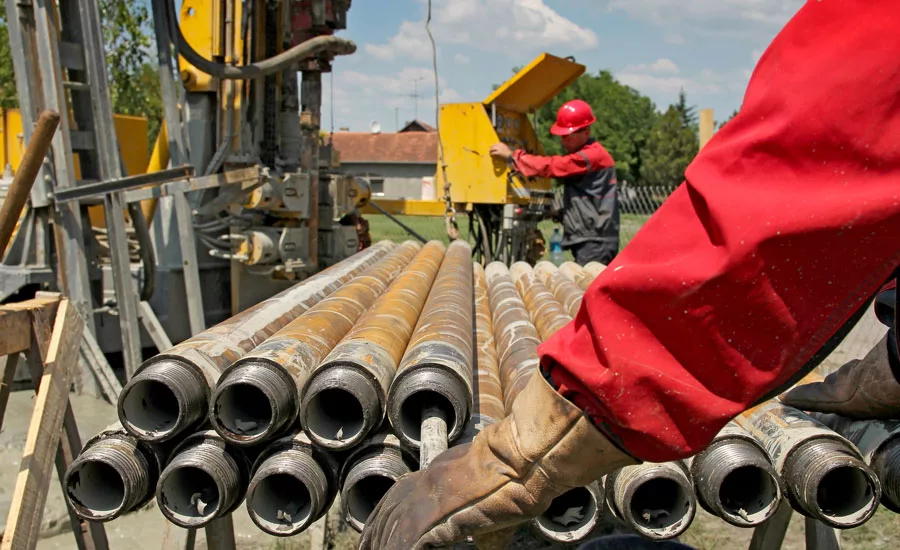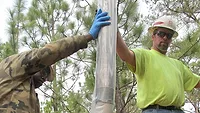We Often Ignore One Big Risk in Drilling: Attitudes toward Safety
A Fresh Look at “Acceptable” Risks, Mitigation in Drilling, Construction

Proper PPE and safety procedures should be obvious, but often the picture on the ground can be less clear.
Source: Getty Images
What is an acceptable amount of risk on drilling projects? The greater question is, what does your team deem as a risk versus a standard daily task?
Our goal as an industry should be to minimize as much risk as possible on a project. The Occupational Safety and Health Administration (OSHA) identifies four hazards that are the highest risk and result in lost time, injuries or casualties. OSHA calls it the “Focus Four Hazards,” and the hazards are:
- Struck-by
- Falls
- Caught-in-between
- And electrical
Any time our team encounters a job or process with these hazards, they should understand the risk involved and be prepared through proper training and procedures to mitigate that risk. But wait! The drilling and pump service industry have more hazards beyond the big four, including:
- Suffocation in confined spaces
- Noxious gas exposure
- Unguarded high-rotating equipment
- Chemical exposure
- Stored energy in high-pressure lines
- And — the biggest one — the attitudes of crews in the field.
Everyone in the industry can use a reminder now and again about each of these hazards, but I want to focus on that last one. Bad choices have deep roots in a mindset that believes, “I am safe and it won’t happen to me.”
“I Feel Safe.”
I remember, as a kid, being scared of the rig. I expected a piece of casing to fall or something to fly off and hit me. By my teens, all of that fear disappeared. I got comfortable with the risk. I worked under suspended loads, stood next to the table, and watched rods spin with no hard hat or safety glasses. By 2000, I heard enough bad stories to wear a hard hat and steel-toed boots, but that was the extent of my PPE. Heck, I felt safe. I thought, I am doing more than many in the industry to protect myself. This isn’t the oil field, so what am I so worried about?
Going to work for Baroid IDP opened my eyes further. Their onboarding process was broad, thorough and covered unknowns I had never thought about. One of the most important lessons taught was staying out of the danger zone when you don’t need to be there. They focused on this major discussion point because of the unpredictable and tribal nature of drilling companies. The thought process was drilling companies have different ways to complete the same task, and some choose to perform these tasks in a riskier manner than others.
During my time in the field as a mud tech I saw many unsafe acts. In the beginning, it was hard to question those risky choices. As my knowledge grew in the field and I witnessed better ways, I started asking customers about the “why” of some of these questionable processes. The most common answer? We have always done it that way, and no one has gotten hurt.
“It Won’t Happen to Me”
How often have you heard something like this statement?
“Everything lined up just right, and they just happen to be in the wrong spot when the failure happened. It was a once in a million situation.”
Does that mean a driller can perform an unsafe process a million times before someone got hurt? Of course not. I have learned about hundreds of one-in-a-million situations while doing Ask Brock. The reality is it is not natural for us to work in high-risk conditions. Given that, our driller brains rationalize why it is ok to be comfortable while working. We convince ourselves that “it won’t happen to me.” When we get comfortable, we become complacent. That one-in-a-million act becomes act 999,999 for you or a teammate who had better plans than the hospital after work. Fellow The Driller writer Dave Bowers has an excellent article on the Cooper code (“Does the Cooper Code Work for Drilling Jobs?” Nov. 2019), which I believe to be one of the best ways for our teams to stay situationally aware. We don’t have to be scared of high-risk situations. However, we must respect proper processes and procedures.
Working in High-Risk Conditions
We work safely in high-risk conditions by identifying the risk and building a plan. Our team must first understand the risk. Next, as a team, we make proper processes to mitigate catastrophic failure. Appropriate techniques require knowledge and good decision-making by our team. Finally, the women and men working in high-risk conditions need formal methods to completely understanding the potential dangers of inappropriate execution. The team and leadership must all know the ramifications of unsafe performance. Lack of supervision and poor leadership allow teams to choose to do unsafe acts.
Conditions or Choices
When OSHA investigates a company for a catastrophic event, the agency asks for training documents, standard operating procedures, job safety analyses, near-miss reporting and reports of other injuries. OSHA’s goal is to build a baseline to determine if the event was a one-in-a-million failure or the result of an imperfect process. Then, the OSHA team utilizes the data to determine whether the event resulted from an unsafe condition or an unsafe act. Traditionally, two-thirds of all construction injuries result from bad choices. Sadly, many of the rules OSHA imposes result from fatalities because those deaths get a lot of attention. We often ignore “lesser,” non-fatal incidents in drilling and construction because many lost-time injuries go unreported. We can develop ways to prevent unsafe conditions as a company, but if those processes aren’t accepted, we create a perfect storm by combining high-risk conditions with bad choices.
Safety Façade
The real question isn’t what you consider acceptable amount of risk or what a crew might consider an “OK” unsafe act. The real question we need to ask: What is our team’s attitude and safety culture for getting the job done? If you ask your team if they have the right tools to get the job done, is the answer “most of them”? If you ask a crew if they feel safe with a specific process, is the answer “sometimes”? These telltale signs call for another look at acceptable risks and the processes to mitigate those risks.
Leadership may look at the paper work and believe their teams and company have a safety culture. However, if the field supervision does not report all the unsafe acts occurring daily, then we do not have a safety culture. We have a safety façade. Contractors and companies in the drilling and construction industries way-too-often think operations are happening safely — until that one-in-a-million injury occurs multiple times in one year.
Leading through Fake into Reality
As an industry, we break through that safety façade by recognizing unsafe acts and educating the industry on better processes. We eliminate that safety façade through leadership with zero-tolerance for dangerous actions and shortcuts. This concept is not easy; it will require redefining project timelines and adjusting operating costs. In addition, teams will have to accept new, safer ways of executing unsafe tasks. Finally, the company may have to consider investments in new tools and equipment to prevent more catastrophic events. Safe operation may not be cheap, but the concept of “faking it until you make it” does not apply to unsafe acts and the real chance of fatality. It is up to everyone in the drilling industry to break the façade.
Have a Question for Brock?
Drill trainer Brock Yordy takes questions in his ongoing video series, Ask Brock. Find episodes at www.thedriller.com/askbrock. Have a question? Send an email to questions@askbrock.com.
Looking for a reprint of this article?
From high-res PDFs to custom plaques, order your copy today!




